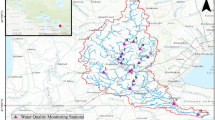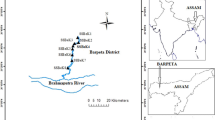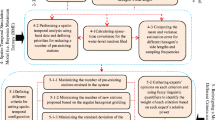Abstract
The design of a water quality monitoring network is considered as the main component of water quality management including selection of the water quality variables, location of sampling stations and determination of sampling frequencies. In this study, an entropy-based approach is presented for design of an on-line water quality monitoring network for the Karoon River, which is the largest and the most important river in Iran. In the proposed algorithm of design, the number and location of sampling sites and sampling frequencies are determined by minimizing the redundant information, which is quantified using the entropy theory. A water quality simulation model is also used to generate the time series of the concentration of water quality variables at some potential sites along the river. As several water quality variables are usually considered in the design of water quality monitoring networks, the pair-wise comparison is used to combine the spatial and temporal frequencies calculated for each water quality variable. After selecting the sampling frequencies, different components of a comprehensive monitoring system such as data acquisition, transmission and processing are designed for the study area, and technical characteristics of the on-line and off-line monitoring equipment are presented. Finally, the assessment for the human resources needs, as well as training and quality assurance programs are presented considering the existing resources in the study area. The results show that the proposed approach can be effectively used for the optimal design of the river monitoring systems.
Similar content being viewed by others
References
Chapra, S. C., & Pelletier, G. J. (2003). QUAL2K: A modeling framework for simulating river and stream water quality: Documentation and users manual. Medford, MA: Civil and Environmental Engineering Dept., Tufts University.
Harmancioglu, N. B. (1981). Measuring the information content of hydrological processes by the entropy concept (pp. 13–38). Journal of Civil Engineering, Faculty of Engineering, Special Issue for the Centennial of Ataturk’s Birth, Ege University, Izmir, Turkey.
Harmancioglu, N. B., & Alpaslan, N. (1992). Water quality monitoring network design: A problem of multi-objective decision making. Water Resources Bulletin, 28(1), 179–192.
Harmancioglu, N. B., Fistikoglu, O., Ozkul, S. D., Singh, V. P., & Alpaslan, M. N. (1999). Water quality monitoring network design (p. 299). Boston: Kluwer.
Karamouz, M., Kerachian, R., Akhbari, M., & Hafez, B. (2008). Optimal design of river water quality monitoring networks: A case study. Environmental Modeling and Assessment. doi:10.1007/s10666-008-9172-4.
Karamouz, M., Kerachian, R., Zahraie, B., & Araghi-Nejhad, S. (2002). Monitoring and evaluation scheme using the multiple-criteria-decision-making technique: Application to irrigation projects. Journal of Irrigation and Drainage Engineering, ASCE, 128(6), 341–350. doi:10.1061/(ASCE)0733-9437(2002)128:6(341).
Karamouz, M., & Maksimović, Č. (2005). Design of Karoon water quality monitoring system and bid evaluation assistance. The World Bank and Iran Department of Environment.
Karamouz, M., Zahraie, B., & Kerachian, R. (2003). Development of a master Plan for water pollution control using MCDM techniques: A case study. Water International, IWRA, 28(4), 478–490.
Mogheir, Y., De Lima, J. L. M. P., & Singh, V. P. (2004a). Characterizing the spatial variability of groundwater quality using the entropy theory: I. Synthetic data. Hydrological Processes, 18, 2165–2179.
Mogheir, Y., De Lima, J. L. M. P. & Singh, V. P. (2004b). Characterizing the spatial variability of groundwater quality using the entropy theory: II. Case study from Gaza Strip. Hydrological Processes, 18, 2579–2590.
Mogheir, Y., De Lima, J. L. M. P. & Singh, V. P. (2005). Assessment of informativeness of groundwater monitoring in developing regions (Gaza Strip Case Study). Journal of Water Resources Management, 19, 737–757. doi:10.1007/s11269-005-6107-6.
Mogheir, Y., & Singh, V. P. (2002). Application of information theory to groundwater quality monitoring networks. Journal of Water Resources Management, 16, 37–49. doi:10.1023/A:1015511811686.
Ozkul, S. (1996). Space/time design of water quality monitoring networks by the entropy method. PhD thesis, Dept. of Civ. Engrg., Dokuz Eylul University, Graduate School of Natural and Applied Sciences, Izmir, Turkey.
Ozkul, S., Harmancioglu, N. B., & Singh, V. P. (2000). Entropy-based assessment of water quality monitoring networks. Journal of Hydrologic Engineering, 5(1), 90–100. doi:10.1061/(ASCE)1084-0699(2000)5:1(90).
Shannon, C. E., & Weaver, W. (1949). The mathematical theory of communication. Urbana, Illinois: University of Illinois Press.
Tirsch, F. S., & Male, J. W. (1984). River basin water quality monitoring network design. In T. M. Schad (Ed.), Options for reaching water quality goals, Proc., 20th annu. conf. of am. water resour. assn. (pp. 149–156). AWRA Publications.
Uslu, O., & Tanriover, A. (1979). Measuring the information content of hydrological process. In Proceedings of the first national congress on hydrology (pp. 437–443). Istanbul.
Wilde, F. D., & Radtke, D. B. (Eds.) (1998). National field manual for the collection of water-quality data-Field measurements: (book 9, chap. A6, p. 238) US Geological Survey Techniques of Water-Resources Investigations.
Woldt, W., & Bogardi, I. (1992). Ground water monitoring network design using multiple criteria decision making and geostatistics. Water Resources Bulletin, 28(1), 45–65.
Author information
Authors and Affiliations
Corresponding author
Rights and permissions
About this article
Cite this article
Karamouz, M., Nokhandan, A.K., Kerachian, R. et al. Design of on-line river water quality monitoring systems using the entropy theory: a case study. Environ Monit Assess 155, 63–81 (2009). https://doi.org/10.1007/s10661-008-0418-z
Received:
Accepted:
Published:
Issue Date:
DOI: https://doi.org/10.1007/s10661-008-0418-z




